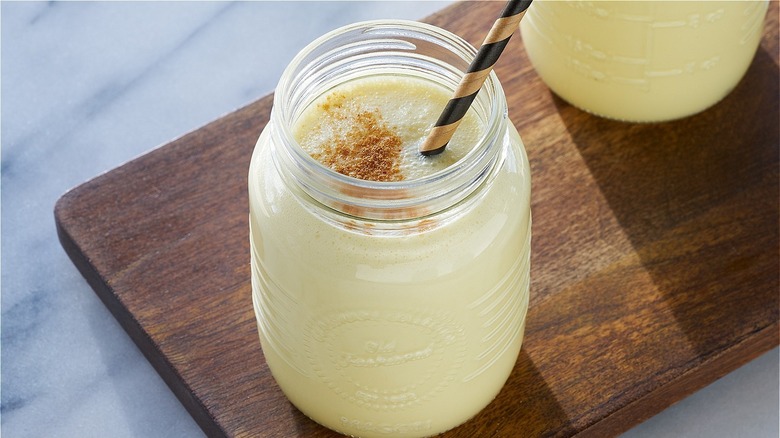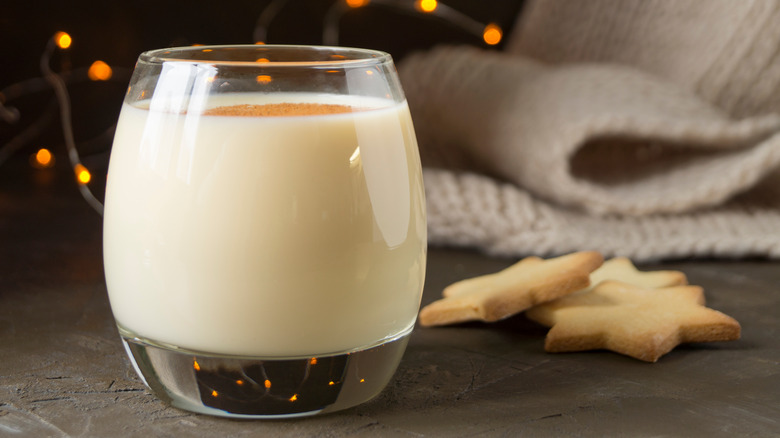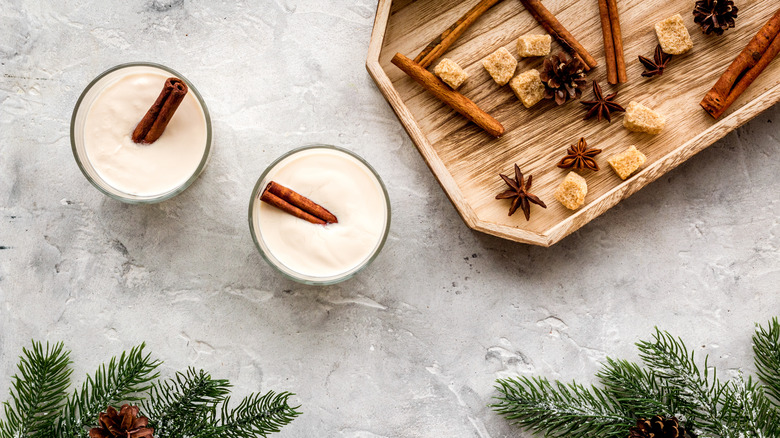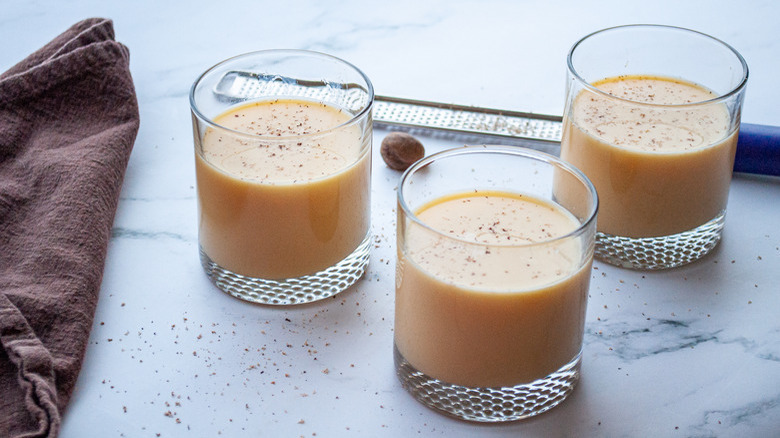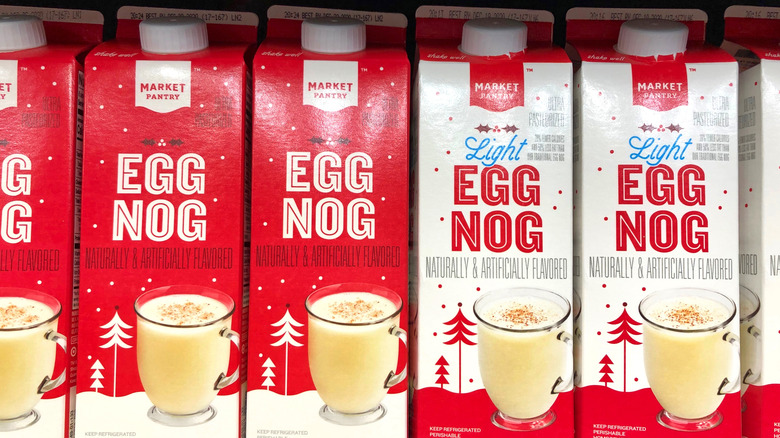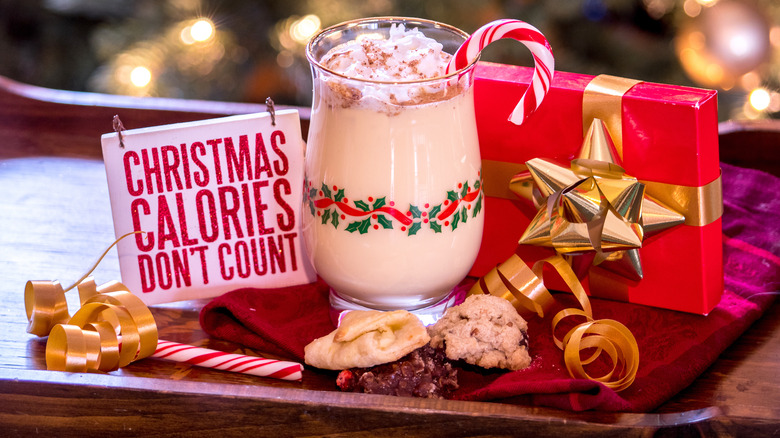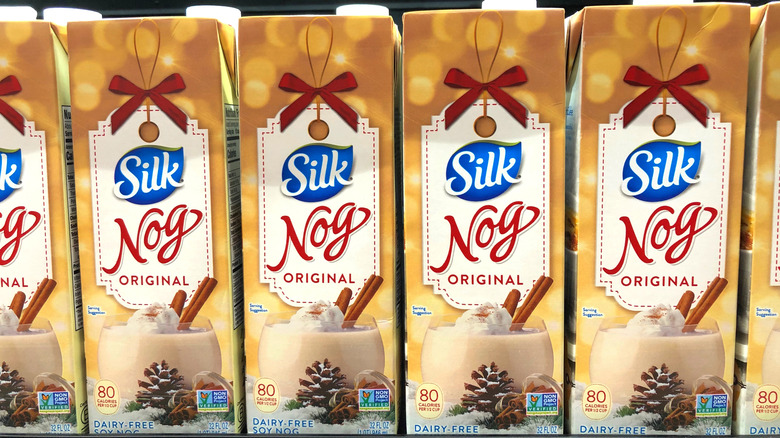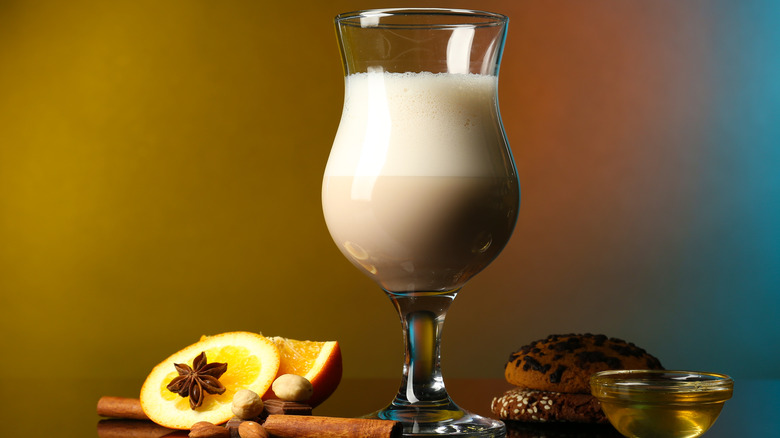What Is Eggnog And Is It Always Alcoholic?
Either you like eggnog, or you don't — there's no in-between. There's nothing else like this unique holiday beverage. It's thick, super sweet, and has a taste you can't quite put your finger on. The drink is a staple at many seasonal dinners and functions, and those who love it often can't do without it when the festive season rolls around.
Eggnog may have been around since your great-great-(keep-adding-greats)-grandparents' day, yet its appeal has not faded with time. If anything, the popularity of the drink continues to rise. For example, annual eggnog production increased significantly from 61 million pounds in 1970 to 124 million pounds in 2008, the Chicago Tribune reports. Today, Americans buy roughly 130 million pounds of the stuff each year (via Vox). That's a whole lot of 'nog to sell for just a few months out of the year. Whether you've yet to try eggnog or are among the legions who love it, there are a few things you ought to know before you take your first sip (or chug) this holiday season.
What is eggnog?
Merriam-Webster defines eggnog as "a drink made of eggs beaten with sugar, milk or cream, and often alcoholic liquor," but recipes are rarely ever that simple; they vary depending on the preferences of the cook and the drinker. Some recipes call for bourbon, and others call for rum. Many even say alcohol is an optional addition. You may also notice that the added spices aren't completely consistent in eggnog: While most recipes call for nutmeg, some blend it into the mixture, some use it only as a garnish, and others do both. Plenty of chefs include cinnamon.
An important eggnog fact to note is that just because it has "egg" in its name, that doesn't mean you're getting a lot of that ingredient. In fact, according to FDA regulations, only 1% of a product's final weight must consist of egg yolk solids for it to be labeled as eggnog. Eggnog-flavored milk requires even less yolk at just 0.5%. If you're a stickler for having actual eggs in your nog, read the carton carefully. As Fox News reports, some products labeled as "holiday nog" contain no egg at all. (Needless to say, the ones labeled "vegan" omit the eggs, as well.)
History of eggnog
Americans may love eggnog, but they didn't invent it. In fact, the treat is older than you probably imagine. The complete history of the drink isn't known, but it's believed that it was first introduced in medieval Britain, according to Time. It wasn't called eggnog then, which makes sense because the hot milk drink, usually served with ale, wine, or another alcohol, did not yet contain eggs. Instead, it was referred to as "posset," and it was probably monks who later added eggs, and sometimes figs, into the mix. Since ingredients like milk and eggs were once expensive and hard to come by, this drink was typically consumed only by the wealthy and reserved for special occasions.
In the 1700s, the creamy drink made it to American colonies, which had plentiful access to its ingredients and combined them with vigor. They did make one major change that seems to have stuck — per PBS, they replaced the top-shelf liquors with cheaper, more common ones like whiskey and rum. Yet another twist on eggnog was developed in the 19th century: the custardy Tom and Jerry, reports Atlas Obscura. While this drink faded into obscurity in most states by the end of the 20th century, it still wouldn't be Christmas in the Midwest today without this warm, thicker take on eggnog.
What does eggnog taste like?
Smooth. Rich. Creamy. Sweet. These are all words that could be used to describe the flavor of eggnog if someone had to give it an elevator pitch. As you are not stuck in a brief conversation with a door-to-door eggnog salesperson, however, we have time to go a bit more in-depth. The drink's smoothness is typical of a dairy-based beverage, while the richness comes from the fact that many types of eggnog are actually made with heavy cream in addition to milk, as is the case in one recipe from Food Network. Even those without cream, particularly the commercial versions, may try to compensate with additives meant to mimic this unctuous mouthfeel.
One thing eggnog does not taste like is eggs. Instead, it tastes mostly of sweetened milk that's flavored with nutmeg and vanilla, as Foodiosity describes. Some might find it reminiscent of pumpkin spice since nutmeg is one of the ingredients included in the seasonal blend, and various nogs include spices such as cinnamon, allspice, and cloves. This description, of course, applies to booze-free eggnog, while versions with alcohol take on another flavor entirely. In some heavy-duty eggnogs, you may not be able to taste much besides brandy, rum, bourbon, or whatever liquor is used.
How to make and cook with eggnog
For most of us, the simplest (and most foolproof) way to prepare eggnog involves nothing more than opening a carton, pouring it into a glass, spiking it with a shot of whatever alcohol we have on hand, and, if we want to get super fancy, dusting it with nutmeg or even sticking a candy cane stirrer in the glass. If you want to DIY the beverage, though, it's probably best to use a recipe that involves cooking your eggnog.
A classic cooked eggnog recipe from Mashed is made with yolks (the whites don't take as well to the cooking), heavy cream, milk, sugar, nutmeg, and a secret eggnog ingredient: vanilla extract. You begin by beating the yolks with the sugar, whisking in the cream and milk, and cooking the mixture low and slow until it thickens, about 10 to 15 minutes. The flavorings are added after it's done cooking, and the booze (if any) can go in once it cools down.
While eggnog is typically consumed as a stand-alone beverage or dessert, it can also be used to make delicious french toast, pancakes, or ice cream. You can even thicken it over a bain-marie and use it as a sauce for pound cake, fruit, and more, as Taste of Home suggests.
Where to buy eggnog
Affordable 'nog is available in the dairy case of nearly every supermarket during the last few months of the year. If you're a steadfast fan of store-bought eggnog, you may want to stock up and stick a few cartons in your freezer since the beverage is typically not widely available year-round. According to Slate, eggnog season usually begins a week or two before Halloween, although some stores may choose to push it out a month earlier. One manufacturer, Prairie Farms, has been known to promote eggnog as an all-fall-long treat by releasing Halloween and pumpkin spice editions of the drink (via Instagram). As for how long eggnog season lasts, the drink generally disappears from shelves around the time people start taking down their Christmas decorations.
There is one other place where you can usually buy eggnog besides the grocery store: the liquor store. Expectedly, these establishments tend to sell the kind that comes in bottles with the booze already included. Unlike the refrigerated variety, this alcoholic eggnog is fairly shelf-stable, says eHow, which means that liquor stores might not be in such a hurry to get rid of it come January. Still, there's always a chance that you can score a sweet discount if they're eager to clear out their holiday items to make room for Valentine's Day champagne.
Nutritional information about eggnog
If you're counting calories, you may want to remove eggnog from your holiday menu altogether. According to Nutrition Data, 1 cup of the drink contains about 343 calories, as well as 19 grams of fat. Just a mug of the stuff has a whopping 21 grams of sugar, which is a lot, considering the World Health Organization's recommendation that adults should take in a maximum of 25 grams of sugar per day. (And in the wintertime, there are plenty of sweet holiday desserts to go around.)
It is possible to create a healthier version of eggnog, however, by swapping out some of the ingredients. You could use 2% milk in place of heavy cream, for example, and reduce the amount of sugar. You could even opt for a calorie-free artificial sweetener, though these have a tendency to impart bitter flavors that might not satisfy the craving you're experiencing (via Food Navigator). Finally, if you're insistent on enjoying the real thing, consider rationing it out: Have a single cup of eggnog for tradition's sake, then switch to something lower in calories, such as a holiday-flavored hard seltzer.
Health risks associated with eggnog
Since traditional eggnog uses raw eggs, the salmonella risk can be real. If you prefer to buy your eggnog from the grocery store, though, you're pretty much safe; according to North Carolina State University, store-bought eggnog has likely been pasteurized to make it safe to drink and unlikely to cause illness. If you're making your own, be sure to take steps to avoid getting yourself or others sick. One solution is to only use pasteurized eggs and egg products, but the Egg Safety Center says there's another FDA-approved way: Gently cook the egg mixture to an internal temperature of 160 degrees Fahrenheit to ensure that it's potable.
If you think adding a healthy serving of alcohol will make your eggnog safe to drink, this assumption is unfortunately incorrect. While booze will kill some pathogens present in raw eggs, it won't completely eliminate your risk of foodborne illness. Sorry, there goes your excuse for pouring whiskey into your 'nog "for health reasons."
Eggnog for special diets
We live in a world where dietary restrictions are plentiful, but that doesn't mean you have to forgo your favorite holiday drink. It's possible to find store-bought options tailored to many restrictions, such as vegan eggnog made with oat milk and cashews by Elmhurst. For the gluten-intolerant, the Celiac-Disease blog reports that most store-bought eggnog is gluten-free, as is the homemade stuff. Always check the ingredients on the label or ask the person who made it, though. And for non-drinkers, store-bought eggnog is almost always a holiday mocktail.
If you're whipping up your eggnog at home, you can of course tailor it to your preferences by making it with egg substitutes, plant-based milk, and as much or as little alcohol as you like. You also have room to add a little flavor boost with extracts from vanilla or rum; the latter trick was favored by the trickster and 19th president Rutherford B. Hayes, who faked spiked eggnog with a touch of fragrant rum extract.
Other varieties of eggnog
Since eggnog originated in Europe, it's not surprising that many European countries have their own subtle twists on the beverage containing eggs, cream, spices, and booze. It's when we get to Latin America, the Caribbean, Asia, and the Middle East, however, that we start to see some truly original eggnog variants. According to The Daily Meal, it's the choice of liquor that makes Colombia's sabajón so out of the ordinary, as it's made with a strong anise-flavored spirit called aguardiente. Ecuador's ponche de leche also features aguardiente but is served hot and adds orange peel as a flavoring. In Mexico, rompope includes almonds and substitutes cinnamon for nutmeg, while Jamaican eggnog often contains white rum and coffee liqueur.
A more distant relative of eggnog is Japan's tamagozake, which omits the milk and cream altogether. Instead, it is simply warm sake whisked with a raw egg and a little sugar, and it's regarded as more of a medicinal drink than a festive one. Finally, in the United Arab Emirates, eggnog gets an alcohol-free, eggless, and healthy twist, containing just chilled camel's milk, pitted dates, and local honey.
